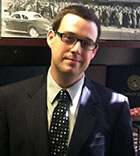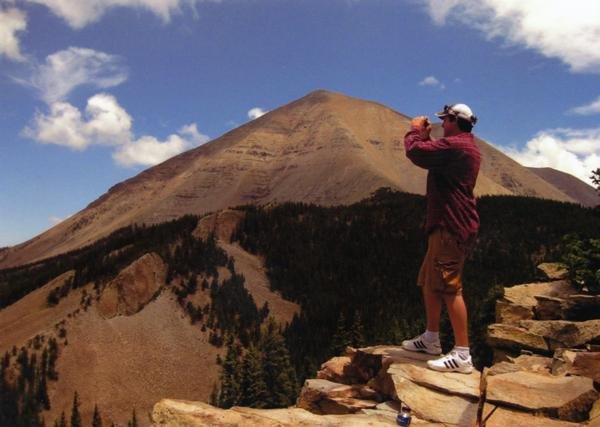For discussion
February 2014
Places and their story: More than just a spot on the map?

Jacob Sowers is currently an assistant professor and coordinator of the geography program at Minot State University. Dr. Sowers is introducing the concept of place identity and how this can be preserved in areas that are undergoing major changes like those experienced by communities on the edge of the oil boom in Western North Dakota, especially in the Minot area.
I have found when most people hear that I am a geography professor they think I am concerned with, and teach, the memorization of states and capitals, locations of foreign countries, or get me confused with a geologist and ask me about rocks. When in fact a geographer has a seemingly endless purview restricted only by his/her curiosity and creativity, and rarely encompasses such trivial matters as the tedious recitation of repetition. One day this past semester, for example, I taught such diverse topics as: why hurricanes make landfall where they do, and the impact of global climate change on their intensity; how the devastating results of the Berlin Conference continue to linger in sub Saharan Africa; the reasons for the avoidance of beef in India; and how the avocado is fueling Mexico’s drug wars. Quite a potpourri, but all of these issues, as well as the countless other topics I lecture about over a semester, have one thing in common, they are stories about global and local interconnections that take place. Geography is about places and their story—the why of where and what is going on there.
Geographers have long recognized that place is much more than a location on a map, and that places are not just containers of action. Places are the necessary tie between a person and their world, making the human experience essentially an unraveling of varying place experiences. As individuals and groups we saturate places with all sorts of identities that help us make sense of the world and ourselves. The identity of a place is made up of the ever-changing medley of landscape, activities, and meaning. Place identity research has allowed geographers a language to probe and explore the development, change, and loss of connections to communities. Whenever there is a dramatic shift in any component of the identity of a place there is an accompanying rupture in the residential identity with place. There are several fundamental identities with place; for example, most longtime residents of a place develop a sense of dwelling, at-homeness, or what geographers refer to as existential insideness. This is an unselfconscious, but essential, mode of being that is the foundation of attachment, dwelling, and rest that remains unnoticed unless the place is changed in some significant fashion. Changes to a place’s landscape, activities, or meaning can accentuate, disturb, or disintegrate a person or group’s identity with place.
Within the general study of place identity, my particular geographical expertise is identifying communities with place identity issues and then finding ways to encourage feelings of at-homeness by recognizing and preserving the resident’s everyday sacred space. Communities who have had their long-standing identity impacted, but not yet destroyed, by a newly introduced and conflicting identity are called ecotone communities. They feature a new diversity of activities, landscapes, and meaning brought in from a new group of people “not from around here,” but because the new identity is in opposition to what has been established there is an increased amount of tension along with a reduction in the feeling of at-homeness. Ecotone communities are special in that it is the place identity that is rapidly changing. So although places are constantly changing, place identities are rather static—communities are bombed, flooded, burned, expand, contract, etc. but their sense of place and identity usually endures, or perhaps grows even stronger. Thus, ecotone communities are not just places undergoing some sort of change; there is a purposeful and unrelenting force changing the landscape, activities, and meaning of a place due to the new group’s intentions. Ecotonal communities occur when the place changes so much and so rapidly that its underlying identity is called into question and longtime residents begin to wonder “what has happened to my town or neighborhood.” People begin to feel like strangers in their hometown.

During my fifteen years of fieldwork, one constant has been that I rarely chose the place of study, the place chose me instead. When I accepted the position at Minot State University in 2012, I had just finished conducting research in Wonder Valley, an unincorporated ecotone community in California’s Mojave Desert. Although I had a couple leads I did not know what town would be my next study area. After a few months living in Minot I quickly came to the realization that Minot was an ecotone community created by the expansion of Bakken oil development. I was actually living in an ecotonal community, and my next research area!
Large-scale landscape modifications such as energy production landscapes cannot help but alter a place’s identity and the residential identity with the place. Oil patches, coal and uranium mines, solar arrays, hydropower dams, wind farms, and others make dramatic impacts on predominately rural landscapes and the surrounding communities. The recent expansion of the Bakken oil field energy landscape has effectively changed the place identity of rural North Dakota. There has been a rupture in the fabric of place in Northwestern North Dakota for the better or worse, depending on whom you speak with. Places such as Williston, Watford City, and Tioga have had their primary place identity completely changed in a very short time to that of an oil boomtown. Minot, because of its relative location to the Bakken and larger population, has been impacted by the oil boom, but has not become an “oil town.” Its landscape, activities and meaning have been significantly changed by the Bakken oil boom, but not so much that it has totally lost its previous identity—it is a great example of an ecotone community.
The oil boom is a reality and it does bring a great deal of benefits to the state, the region, and to Minot. It also creates some problems. My research does not battle, nor blindly embrace the oil boom; instead it sees a region full of communities caught up amidst great change, with many residents feeling alienated in their hometowns. I must make clear that small or great change to a community is neither good nor bad. What makes change a problem is when there is a great disturbance in “dwelling” or the ability to feel at-home in one’s hometown. Many residents in Minot have experienced a harmful shift in their place experience, going from dwelling and at-homeness to that of alienation and nostalgia. Geographers refer to this shift in place attachment as an experiential displacement from existential insideness to existential outsideness. My current research seeks to reverse this trend by seeking and sustaining the everyday sacred spaces and places where the community has grown or could grow strong roots.
Specifically my research has four major objectives to accomplish this goal:
- Delineate essential elements of Minot’s sense of place before the oil boom through interviews and surveying citizens with over ten years of residency. This step will set up a baseline of what Minot’s place identity was prior to the oil boom—what landscapes, activities and meanings are held in high esteem.
- Discover the everyday sacred spaces and places all around Minot through surveys, interviews, geo-diaries, and photographic evaluations. This will open up a dialogue and make explicit those special places that are treasured by many.
- Hold discussions with various community decision makers, residents and other stakeholders to determine steps that need to be taken to celebrate, sustain and preserve the everyday sacred spaces.
- Meet with community decision makers and residents to envision the types, and possible locations, of everyday sacred spaces/places that should exist, and set up procedures to actualize these possibilities.
One of the goals of geography is to examine and clarify sacred place experiences and prescribe possible ways to sustain and improve the meaningfulness of the special places that nurture our lives. It is self-evident that without an empathetic and accurate description of these places there can be little hope for a proper prescription to sustain them. The goal of my research is to awaken people to the importance of spaces and places that are foundational to their experience of Minot, find out where these are, determine ways to sustain them in the midst of great change, imagine spaces or places that do not yet exist but if created would accentuate the experience of Minot residents. My desire is to simply make explicit what is implicitly held dear to a community so that this special sense of place can be nurtured, and not lost. People will come and go out of our lives, but we will always be in place. I want to make sure that Minot is the kind of place that the residents desire and deserve.
